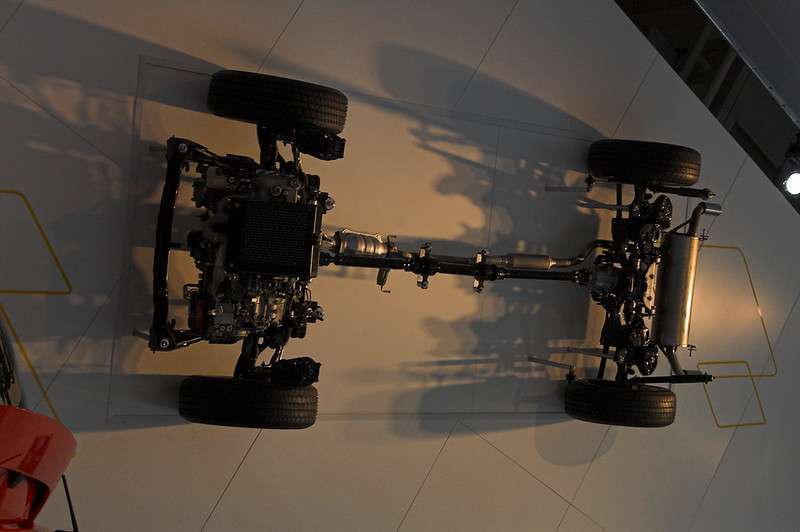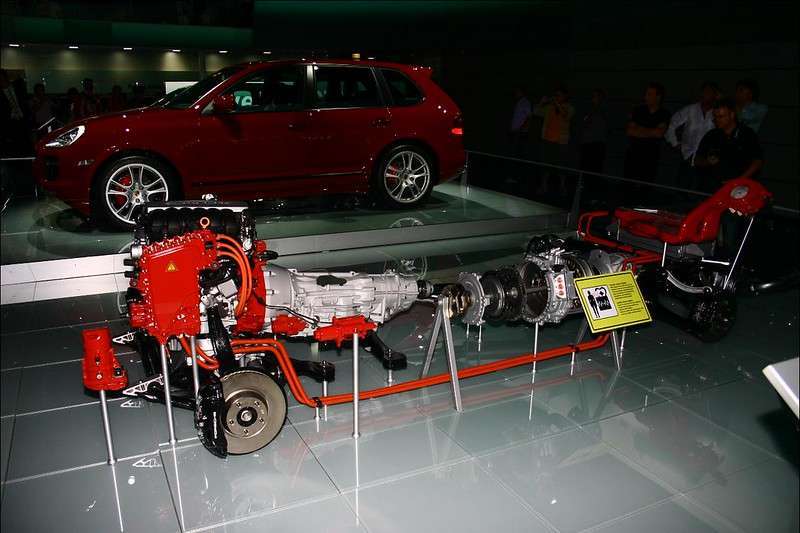There is a huge difference between four wheel drive and all wheel drive vehicles. Most people don’t know how to differentiate these two types of drivetrains.
All-wheel drive system automatically detects the driving conditions or road surface when you’re driving. Afterwards, it automatically switches from two-wheel drive to four-wheel drive.
This is without the driver’s participation. However, a four wheel drive system has two options. One whereby the driver’s participation is necessary to switch from two-wheel to four wheel drive and anther where it isn’t.
These remarkable machines possess the power to enhance performance and navigate through the toughest of conditions. Unlike their two-wheel drive counterparts, four-wheel drive vehicles provide power to all four wheels simultaneously.
This feature ensures maximum traction and control and is commonly found in off-road vehicles and trucks. Once wheel spin is detected, the wheel drive system will allocate power between the front and rear wheels.
It utilizes components such as transfer cases, secondary axles, differentials, and more to distribute torque effectively. This advanced technology does not compromise safety or thrill, no matter where you venture off.
Four-wheel drive vehicles should be at the top of your list when you’re planning an exhilarating off-road trip. Because they can handle any terrain with ease.
4WD vs 4×4: What’s the difference?
“4WD” and “4×4” have several distinct features meaning that they’re not the same. The “4×4” vehicles are a type of vehicle that belongs within the “4WD” category.
Therefore, “4WD” vehicles usually have selectable four-wheel drive systems. Whereby, the driver can engage the feature whenever he/she is in need.
However, “4×4” vehicles have a permanent four-wheel drive. Meaning that they distribute engine power to both the rear axle and front axle at all times during your drive.
Therefore the “4×4” vehicles place a higher demand for power on the engine in comparison to the “4WD” vehicles. This makes them consume more fuel in order to satisfy the demand for engine power.
The main difference between these two types of drivetrains lies in how the power is distributed to all four wheels. This is one of the factors of distinction when referring to different drivetrains.
4WD vehicles.
4WD vehicles allow drivers to switch between two-wheel drive and four-wheel drive modes as needed. Hence providing flexibility for different driving conditions.
This flexibility also affects performance. Whereby, performance doesn’t decrease when driving on paved roads. Since driving there doesn’t require engine power transfer to all wheels.
Furthermore, there is no compromise on performance when driving on rugged terrain. Because the driver can set the torque distribution to both the rear wheels and front wheels.
4×4 vehicles.
On the other hand, 4×4 vehicles have a fixed power distribution. Whereby all four wheels receive engine power simultaneously at all times.
Therefore, there is no option to switch between two-wheel drive and four-wheel drive modes when the driving conditions are suitable.
They excel in providing continuous traction on various surfaces like snow-covered roads or slippery conditions. The road surface on which you’re driving a 4×4 vehicle doesn’t matter because you’ll always have maximum traction.
Comparison of 4×4 with 4WD.
| 4×4 Vehicles | 4WD Vehicles |
| 4×4 systems demand less attention since they operate continuously without driver intervention. | 4WD systems may require occasional engagement checks and fluid changes due to lots of driver intervention. |
| 4×4 is suitable for off-road adventures or challenging terrains where extra traction is necessary. | 4WD is suitable for both off-road and paved roads where extra traction is necessary intermittently. |
| Consume more power to support extra traction full-time. | More fuel efficient since extra traction depends on the driving conditions. |
It’s important to note that both systems offer advantages depending on specific driving needs and preferences.
How does four-wheel drive work?

In a four-wheel drive system, power distribution is even between the front and rear axles. This configuration improves traction by allowing all wheels to rotate at the same speed.
However, where wheel slip is detected, more power is directed to the wheels that have higher traction. The transfer case plays a crucial role in controlling the distribution of power between both axles.
Here’s how four-wheel drive works:
Power distribution.
In a four-wheel drive system, engine power is sent to both the front and rear axles simultaneously. This ensures that all wheels receive an equal amount of torque.
Hence enhancing traction on various terrains. Furthermore, this feature makes it easier to drive in snow, deep sand, slippery roads and off-road.
Traction improvement.
By enabling all wheels to rotate at the same speed, four-wheel drive enhances traction. Either on slippery roads or off-road conditions.
Having power delivered to all wheels allows for better control and stability. Since the vehicle grip is better than in front-wheel drive and rear-wheel drive systems.
Transfer case control.
The transfer case acts as the command center for distributing power between the front and rear axles. In 4WD it allows the driver to electronically change from two wheel drive mode to all wheel drive mode.
Furthermore, it contains gears that allow drivers to select different driving modes. For example, 4H (four-wheel high) or 4L (four-wheel low), depending on their requirements.
Types of four-wheel drive.
Drivers will either go for full-time AWD, part-time 4WD, or advanced systems depending on their needs. Let’s take a closer look at these types of drive train systems.
Full-time 4WD.
This type of system ensures continuous power to all wheels without requiring any intervention from the driver. It offers enhanced traction and stability in various driving conditions.
Hence making it suitable for mostly off-road adventures. However, the constant traction is not necessary for on-road driving.
Because it places a high strain on the car engine. Since it requires a lot of power to consistently maintain that level of traction.
Part-time 4WD.
With part-time 4WD, drivers have the flexibility to manually engage or disengage four-wheel drive as needed. They mostly use an electric system set as a button with the option of 4WD mode.
This allows them to optimize fuel efficiency by using two-wheel drive when road conditions are favorable. Yet they still have the option to switch to four-wheel drive in challenging terrains.
Advanced systems.
Some vehicles come equipped with advanced systems that offer multiple modes for different driving conditions. Manufacturers of such vehicles put in a lot of work to deliver on the drivetrain’s adaptability.
These systems allow drivers to select specific settings such as snow, mud, or sand mode. Afterwards, the vehicle’s performance adapts accordingly.
This versatility ensures optimal traction and control in diverse environments. You will notice that such systems are expensive to install therefore, the vehicle’s price is also high.
There are various drivetrain configurations available across different car body styles. Whether you prefer a sedan, SUV, or pickup truck, there is a type of drivetrain that suits your needs.
Advantages of four-wheel drive in snowy conditions.
When driving in snowy conditions, having a four-wheel drive vehicle can offer several benefits. Here are some advantages to consider:
Improved traction.
Four-wheel drive vehicles excel at providing better traction on snow-covered roads. They distribute power more evenly when all four wheels are engaged simultaneously.
Hence allowing for increased grip and reducing the chances of getting stuck. Furthermore, this offers the driver more control of the vehicle by improving steering responsiveness.
Prevents wheel spin.
One of the main advantages of four-wheel drive is its ability to prevent wheel spin. Wheel spin happens when one tire starts moving at a higher speed than the others.
Its common in snowy conditions, whereby a single wheel loses traction and starts spinning. the system detects this and directs torque to other wheels with grip.
Afterwards, they are empowered to continue propelling the vehicle forward. This feature is particularly useful when navigating steep slopes or icy patches.
Enhanced control and stability.
In order to enhance a four-wheel drive vehicle’s control and stability during winter driving, install appropriate winter tires. Regular weather tires don’t have the level of grip that’s custom for winter conditions.
The combination of all-wheel power distribution and specialized tires ensures better handling on slippery surfaces. It allows drivers to maintain control through steering responsiveness even in challenging conditions.
Safer driving experience.
This is a point that is relative to the vehicle make and model as well as the manufacturer of that vehicle. Recent four-wheel drive vehicles offer benefits that extend beyond just traction and control.
Many models come equipped with additional safety features that further enhance the overall driving experience in snowy conditions.
For example, anti-lock braking systems (ABS), electronic stability control (ESC), and traction control systems (TCS).
Effective use of four-wheel drive: tips and guidelines.
The following are some of the ways for you to use the four-wheel drive system that maximize results.
Engage four-wheel drive early enough.
Engage four-wheel drive before encountering challenging terrain. This ensures that your vehicle is ready to tackle the rough conditions ahead.
By engaging four-wheel drive in advance, you can maximize traction and control. Hence making it easier to navigate through mud, snow, or uneven surfaces.
Early engagement allows the drivetrain sufficient time to adjust before you encounter challenging conditions. It warms up the rear differential fluid for power transfer purposes.
Where to and not to use 4WD.
Avoid using four-wheel drive on dry, paved roads to prevent damage to the drivetrain. Some drivers tend to engage four-wheel drive for added stability or power no matter the driving conditions.
Doing so when road conditions don’t warrant it can cause unnecessary strain on your vehicle’s components. Save the use of four-wheel drive for when you truly need it.
Adjust driving techniques.
Understand the limitations of your vehicle’s four-wheel drive system and adjust driving techniques accordingly. All four-wheel drive systems are not created equal.
Therefore, each one of them may have its own set of capabilities and restrictions. Familiarize yourself with your specific system’s capabilities.
Consult the owner’s manual or alternatively, seek guidance from a knowledgeable professional. Afterwards, adjust your driving technique based on these limitations.
This will help you make the most effective use of your four-wheel drive. Furthermore, you will avoid straining the drivetrain and other vehicle components.
Driving on challenging terrains.
Observe the following guidelines especially when using four-wheel drive for off-road adventures or challenging terrains:
- Maintain a steady speed to prevent wheel spin.
- Avoid sudden acceleration or braking to maintain control.
- Keep a safe distance from other vehicles to allow for ample reaction time.
- Be mindful of any obstacles that could potentially damage your vehicle.
Harnessing the power of four-wheel drive.
Now that you understand the basics of four-wheel drive (4WD) and all-wheel drive (AWD), it’s time to put that knowledge into action.
Harnessing the power of four-wheel drive can make a world of difference in your driving experience. Whether you’re tackling rough terrains or navigating through snowy conditions.
So, how can you make the most out of this incredible feature?
When to engage the 4WD system.
First and foremost, always remember to engage your 4WD system before entering challenging terrain. This will ensure that power is distributed evenly to all four wheels for maximum traction and control.
Using 4WD in different conditions.
Be mindful of your speed when using four-wheel drive in slippery conditions – slow and steady wins the race! This will reduce chances of wheel slip and therefore your drivetrain and engine won’t strain.
Maintenance.
Lastly, don’t forget to observe regular maintenance on your 4WD system to keep it running smoothly. Create a maintenance schedule and adhere to it or follow your car manufacturer’s recommendations.

